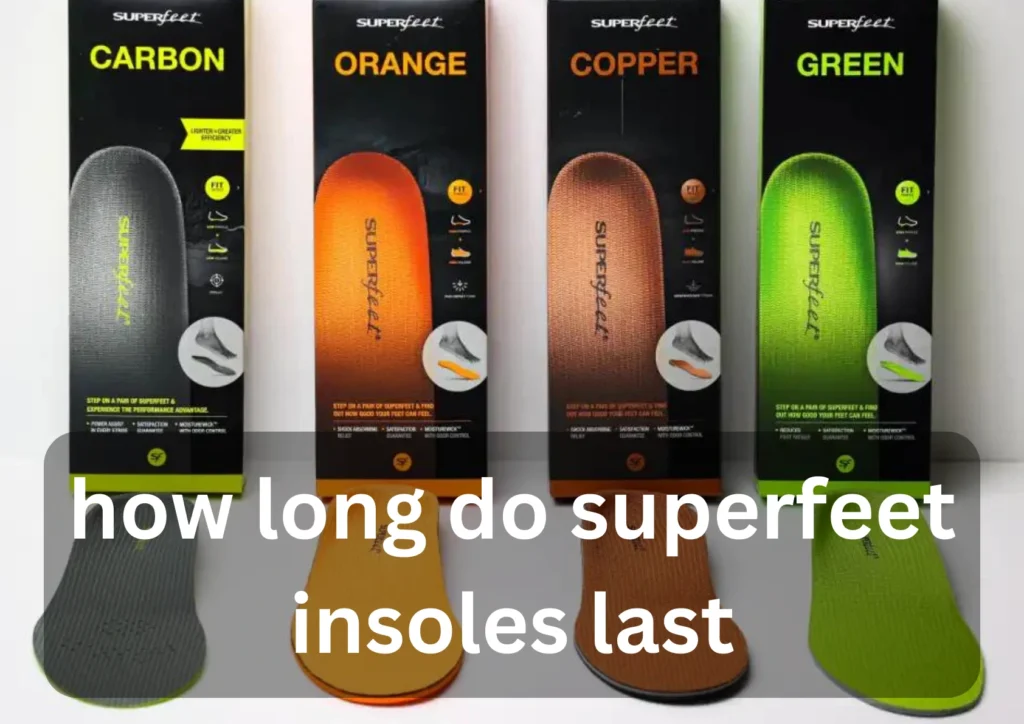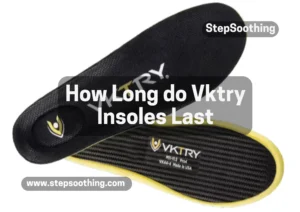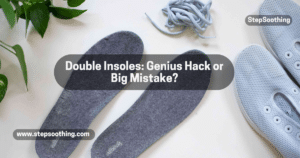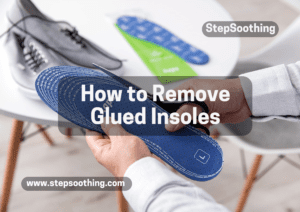Superfeet insoles are designed to provide long-lasting comfort, pain relief, and performance, but like all footwear accessories, they don’t last forever. A common question among users is: how long do Superfeet insoles last? The lifespan of Superfeet insoles depends on factors like activity level, mileage, and wear patterns. Generally, they should be replaced every 500 miles or 12 months, whichever comes first. Understanding when and how to replace them ensures you maintain proper foot support and move comfortably every step of the way.

When to Replace Your Superfeet Insoles
Superfeet insoles are designed to provide Comfort, Pain Relief, and Performance, but like all footwear components, they wear down over time. A common misconception is that insoles last forever; however, they should be replaced approximately every 500 miles or 12 months, whichever comes first. If you use them regularly for activities such as walking, running, or hiking, checking for signs of wear is crucial to maintaining a pain-free gait cycle.
👉 Learn more about the benefits of using insoles for foot health and how they improve overall comfort.
Signs Your Superfeet Insoles Need Replacement
Here are key indicators that it’s time for a new pair:
- Visible Wear and Tear – Look for white marks, fabric worn through, or the logo fading. The foam and top cover may also appear compressed.
- Structural Breakdown – If the plastic heel cup or medial arch support shape has lost its integrity, the insoles won’t function as designed.
- Loss of Comfort and Support – If walking or running starts feeling less comfortable, with increased foot fatigue or heel pain, your insoles may no longer be providing optimal support.
How Often Should You Replace Superfeet Insoles?
Superfeet insoles are built to last, but their effectiveness diminishes over time. They should typically be replaced every 12 months or after 500 miles of use. If you engage in high-impact activities such as running or hiking, you may need to replace them sooner.
👉 Find out how to choose the right insoles based on your activity level and foot type.
What Is the Lifespan of Superfeet Insoles?
The lifespan of Superfeet insoles depends on usage, but on average, they last between 6 to 12 months with regular wear. If you use them daily or for intense activities, the foam and arch support may wear out more quickly.
When Should I Stop Wearing Insoles?
You should stop wearing your current Superfeet insoles if you notice:
- Reduced support or discomfort in your feet, knees, or back.
- Signs of significant wear, such as flattened foam or a deformed heel cup.
- Persistent foot pain that doesn’t improve with the insoles.
If you experience any of these issues, replacing your insoles or consulting a professional for alternative support is recommended.
What Is the Life Cycle of an Insole?
The life cycle of an insole typically includes:
- Initial break-in period – The insoles mold slightly to your feet within the first few wears.
- Peak performance – Provides optimal support and cushioning for several months.
- Gradual wear and tear – Compression of foam, reduced arch support, and visible signs of wear.
- Replacement time – After 500 miles or 12 months, insoles should be replaced to maintain comfort and performance.
Choosing the Right Replacement
Superfeet offers a range of insoles tailored to different activities, footwear styles, and arch profiles. Whether you need All-Purpose, Run, Hike, Casual, or Hockey insoles, the Superfeet Insole Finder quiz can help recommend the best option for your needs. This tool asks targeted questions about your feet, footwear, and activities to ensure you get a perfect fit.
👉 Check out this guide on how to wear insoles correctly for maximum comfort and support.
How to Trim and Fit Superfeet Insoles
Superfeet insoles come in full-length sizes that can be trimmed for a customized fit. Follow these steps for the best results:
- Place your new insole on top of the existing sock liner to compare length.
- Using a marker, trace the outline of your original insole.
- Trim the excess using scissors – avoid over-trimming, as you can always fine-tune the edges later.
- Insert the insole and ensure it lays flat inside your shoe for proper function.
Caring for Your Superfeet Insoles
To extend the lifespan of your insoles, follow these cleaning instructions:
- Hand-wash occasionally using mild soap, lukewarm water, and a soft-bristle toothbrush.
- Rinse thoroughly and remove excess water with a soft towel.
- Air dry completely before reinserting into shoes.
- Never MACHINE WASH or DRY your insoles, as heat exposure can degrade materials.
Sustainability and Manufacturing Excellence
Superfeet prioritizes sustainability across all aspects of its business. The headquarters in Ferndale, Washington, is powered by renewable energy, and the company actively reduces waste by eliminating unnecessary plastic in packaging. Many insoles are made with recycled materials, supporting ambitious science-based emission reduction targets.
Each Superfeet insole features a proprietary shape and is engineered based on biomechanic studies to stabilize feet and improve movement patterns. The structured heel cup cradles soft tissue, while the deep, three-dimensional shape interacts with the foot’s natural contours for maximum impact absorption.
👉 Curious if Superfeet insoles are worth the investment? Read this in-depth review to find out.
Superfeet vs. Custom Orthotics
Superfeet insoles provide a three-dimensional fit that enhances foot function, but they differ from custom orthotics, which are prescribed by podiatrists using digital scans or casts. While custom orthotics can cost $400-$600, prefabricated insoles like Superfeet offer similar benefits at a lower cost. Studies have shown that prefabricated orthotics can help reduce plantar heel pain and other conditions within eight weeks, making them a practical alternative for most users.
Step-by-Step Cleaning and Care Instructions
- Gentle Cleaning: Use a mild soap solution and a soft brush to clean the insoles. Avoid submerging them in water to prevent material damage.
- Drying Techniques: Air dry the insoles thoroughly before reinserting them into your shoes. Placing them near a fan aids in faster drying without compromising their structure.
- Insole Freshness: To maintain freshness, sprinkle baking soda or use activated charcoal inserts. These natural deodorizers neutralize odors, ensuring your insoles stay odor-free.
Expert Tips for Prolonging Insole Longevity
- Regular Inspections: Periodically inspect your insoles for signs of wear. Catching issues early allows for timely replacements, preventing discomfort.
- Consultation: If you experience persistent discomfort, consult a podiatrist. They can assess your foot structure and recommend the most suitable Superfeet insole model.
- Seasonal Rotation: If you own seasonal footwear, rotate insoles accordingly. Winter boots might require different insoles than summer sandals, ensuring appropriate support year-round.
User Testimonials and Experiences
User experiences are invaluable in understanding the practical aspects of Superfeet insoles. Let’s explore stories from users, addressing both positive experiences and challenges faced.
Long-Lasting Superfeet Insole Stories
Sarah’s Story: Sarah, an avid hiker, shares her experience with Superfeet Trailblazer insoles. Despite rugged terrains and constant use, her insoles have lasted over a year, providing unmatched support and durability. She emphasizes the importance of regular cleaning and rotation.
Mark’s Endorsement: Mark, a professional athlete, commends Superfeet Carbon Pro insoles for their longevity. Despite intense training sessions and daily wear, his insoles maintained their shape and support. He credits their high-quality materials for the prolonged lifespan.
Common Issues Faced by Users and Solutions
Jennifer’s Dilemma: Jennifer faced discomfort with her new Superfeet insoles, assuming they were unsuitable. After consulting a podiatrist, she realized her arch type needed a different Superfeet model. Upon switching, her discomfort vanished, highlighting the importance of choosing the right insole for individual foot needs.
Tom’s Wear Patterns: Tom noticed uneven wear on his insoles, leading to foot pain. Expert advice revealed his shoes were too tight, causing pressure points. After adjusting his footwear, he rotated between two pairs of insoles, ensuring uniform wear and resolving his discomfort.
Inviting Readers to Share Their Stories
Have you had a remarkable experience with Superfeet insoles? We invite you to share your stories. Your insights can help others navigate the world of insoles, fostering a community of informed users.
Final Thoughts
Replacing your Superfeet insoles on a regular basis ensures that they continue to provide the support and efficiency they were designed for. Whether you’re an athlete, a daily walker, or someone dealing with foot pain, having the right insoles in your shoes will help you move comfortably and do the things you love, pain-free. If you’re unsure which product suits you best, use the Superfeet Insole Finder quiz or search for your go-to insole by name on the website.
By keeping your insoles in top condition, you’re investing in long-term foot health, better movement efficiency, and an overall improved quality of life.
People Also Ask
How do you know when Superfeet are worn out?
Superfeet insoles should be replaced every 500 miles or 12 months, whichever comes first. Signs of wear include white marks, a compressed foam layer, worn fabric, and reduced support or comfort.
How long do Superfeet insoles last?
Superfeet insoles typically last 500 miles or 12 months, depending on usage. If you start experiencing discomfort, fatigue, or visible wear, it’s time for a replacement.
When should I stop wearing insoles?
If your insoles no longer provide support, show visible wear, or contribute to foot pain, it’s time to stop using them and replace them with a new pair.
Can I trim my Superfeet insoles for a better fit?
Yes! Superfeet insoles are full-length and can be trimmed using scissors for a perfect fit inside your footwear. Be sure to follow the trimming instructions carefully to avoid over-cutting.
Are Superfeet insoles comfortable for daily wear?
Absolutely! Superfeet insoles are designed for comfort and pain relief, making them ideal for walking, running, and daily activities.



